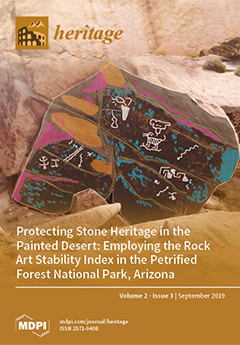In the framework of the protection of copper objects exposed to atmospheric corrosion, different solutions are envisaged, among them carboxylate treatments (HC
10). In this study, an analytical approach based on complementary techniques from micrometer to nanometer scale (μRS, SEM-EDS, SAM) is
[...] Read more.
In the framework of the protection of copper objects exposed to atmospheric corrosion, different solutions are envisaged, among them carboxylate treatments (HC
10). In this study, an analytical approach based on complementary techniques from micrometer to nanometer scale (μRS, SEM-EDS, SAM) is used to describe the properties of the corrosion products layer (CPL) and determine the penetration depth of the HC
10 protection treatment inside the CPL of copper samples issued from the roof of the Saint Martin church in Metz. The CPL consists in a thick brochantite layer (20 to 50 μm), mainly composed of Cu
4SO
4(OH)
6, on top of a thinner (1 to 5 μm thick) cuprite layer, Cu
2O, acting as a natural corrosion barrier on the metal. Application of the organic treatment is implemented by immersing the corroded samples in HC
10 solution, consistent with future requirements for large scale applications. Even for short-term duration (one minute), the HC
10 treatment penetrates to the cuprite/brochantite interface, but Cu(C
10)
2 precipitate is only detected locally, whereas for a longer immersion of thirty minutes, it is present in higher proportions in the whole brochantite layer, filling the pores, up to the cuprite/brochantite interface. Cu(C
10)
2 acts as a second inner barrier and prevents liquid infiltration.
Full article





